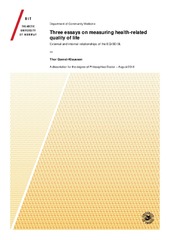Sammendrag
The use of quality-adjusted life years (QALYs) as a commensurable health outcome measure has been encouraged by health authorities in many countries in order to aid decisions on healthcare priorities. A key methodological challenge is to estimate the weights used for valuing health-related quality of life, i.e. the “Q” in QALY, based on people’s preferences. Such generic preference-based measures (GPBMs) comprise a descriptive system and a value set that assign a value to each health state description on a 0 to 1 scale.
The objective of this thesis was to provide improved knowledge of the usefulness of GPBMs, with an emphasis on the most widely applied instrument, the EQ-5D. More specifically, the thesis aims to i) investigate into the degree of non-linear relationships across GPBMs and provide exchange rates that differ depending on disease severity (Paper 1); ii) develop mapping algorithms from depression scales (DASS-21 and K10) onto the EQ-5D (Paper 2) and iii) explore the causal and effect nature of EQ-5D dimensions (Paper 3). The analysis are based on an international sample from the Multi Instrument Comparison (MIC) project. A total of 7933 participants aged 18 years and above were included and separated into a non-diagnosed healthy group (n=1760) and seven disease groups (n=6173).
In Paper 1, quantile regression was used to investigate the degree of non-linear relationships between GPBMs (EQ-5D, SF-6D, HUI, and 15D) at nine different quantiles. Furthermore, the health state utility scale was split into intervals with 0.2 successive utility decrements to compare the GPBMs across different disease severities. The ER was calculated as the mean utility difference between two utility intervals on one GPBM divided by the difference in mean utility on another GPBM. The result revealed significant non-linear relationships across all four GPBMs. The degrees of non-linearity differed, with a maximum degree of difference in the coefficients (measured by the ratio of the largest to the smallest coefficient). ERs also differed by disease severity: at the lower end of the health state utility scale, the ER from SF-6D to EQ-5D was 2.19, while at the upper end it was 0.35. These results illustrate the inaccuracy of using linear functions as cross-walks between GPBMs and suggest that level-specific exchange rates should be used when converting a change in utility on one GPBM onto a corresponding utility change on another GPBM.
Paper 2 aimed to develop mapping algorithms from two widely used depression scales: the Depression Anxiety Stress Scales (DASS-21) and the Kessler Psychological Distress Scale (K10) onto the EQ-5D-5L. Eight country-specific value sets (England, the Netherlands, Spain, Canada, China, Japan, Korea, and Uruguay) were applied. Data was based on the depression subgroup (n=917) of the MIC study. Six regression models were employed, including ordinary least squares regression, generalized linear models, beta binomial (BB) regression, fractional regression model, the MM-estimator, and censored least absolute deviation. Three model performance criteria were calculated to select the optimal mapping function for each country-specific value set: root mean square error, mean absolute error, and adjusted-r2. Generally, the results revealed that the fractional regression model was preferred in predicting EQ-5D-5L utility values from both the DASS-21 and K10. The only exception was the Japanese value set, for which BB regression model performed best. The mapping algorithms can adequately predict EQ-5D-5L utility values from scores on the DASS-21 and K10. This enables disease-specific data from clinical studies to be applied to estimate outcomes in terms of QALYs for use in economic evaluations.
Paper 3 aimed to develop a conceptual framework for causal and effect relationships among the five dimensions of the EQ-5D (mobility, self-care, usual activities, pain/discomfort, and anxiety/depression) based on theoretical models of HRQoL, and test this framework using empirical data. The conceptual framework depicted the dimensions pain/discomfort and anxiety/depression as causal indicators that drive a change in the effect indicators of activity/participation, mobility, self-care, and usual activities. Note that mobility has also an intermediate position between pain/discomfort and the other two effect dimensions (self-care and usual activities). Confirmatory tetrad analysis (CTA) and confirmatory factor analysis (CFA) were used to test this framework using the full sample from the MIC project (N=7933). CTA produced the best fit for a model specifying self-care and usual activities as effect indicators and pain/discomfort, anxiety/depression, and mobility as causal indicators. This was supported by CFA, which revealed a satisfactory fit to the data based on the comparative fit index=0.992, the Tucker-Lewis index =0.972, the root-mean square error of approximation =0.075 (90% CI 0.062-0.088), and the standardized root-mean square residual =0.012. The EQ-5D-5L appears to include both causal indicators (pain/discomfort and anxiety/depression) and effect indicators (self-care and usual activities). Although mobility played an intermediate role in our conceptual framework, the analysis suggested that it is mostly a causal indicator.
Har del(er)
Paper I: Gamst-Klaussen, T., Chen, G., Lamu, A.N., & Olsen, J.A. (2016). Health state utility instruments compared: inquiring into nonlinearity across EQ-5D-5L, SF-6D, HUI-3 and 15D. Quality of Life Research, 25(7), 1667-1678. Full text not available in Munin due to publisher restrictions. Published version available at https://doi.org/10.1007/s11136-015-1212-3. Accepted manuscript version available at http://hdl.handle.net/10037/8867.
Paper II: Gamst-Klaussen, T., Lamu, A.N., Chen, G., & Olsen, J.A. (2018). Assessment of outcome measures for cost-utility analysis in depression: mapping depression scales onto the EQ-5D-5L. BJPsych Open, 4(4), 160-166. Also available at http://hdl.handle.net/10037/13180.
Paper III: Gamst-Klaussen, T., Gudex, C., & Olsen, J.A. (2018). Exploring the causal and effect nature of EQ-5D dimensions: an application of confirmatory tetrad analysis and confirmatory factor analysis. Health and Quality of Life Outcomes, 16(1), 153. Also available at http://hdl.handle.net/10037/13984.


 English
English norsk
norsk
